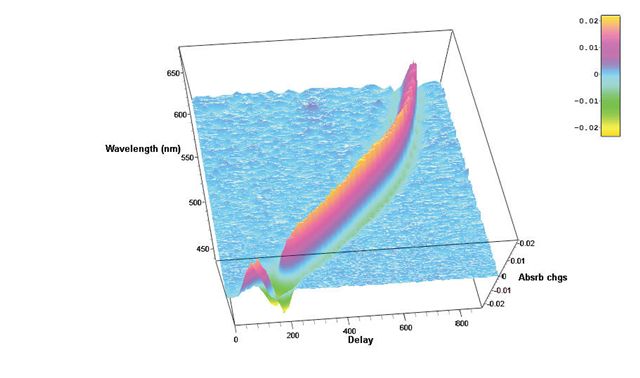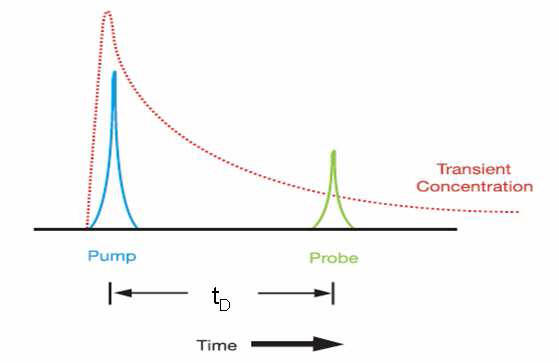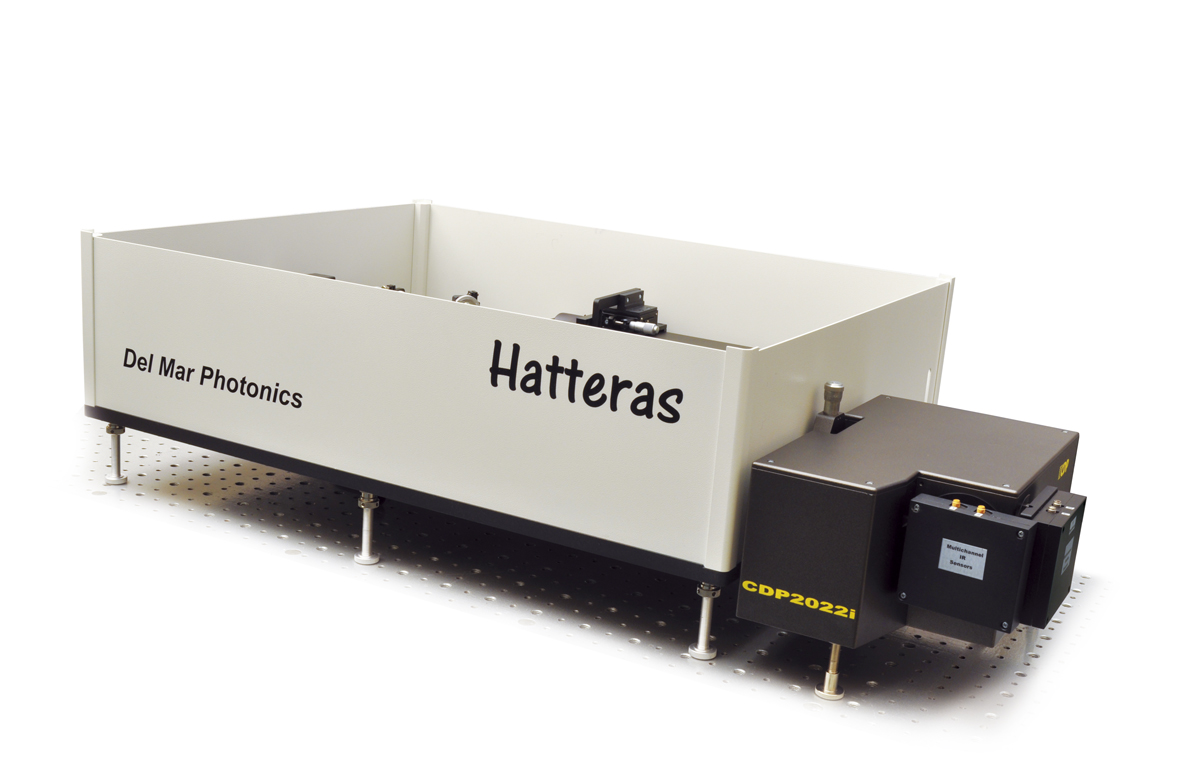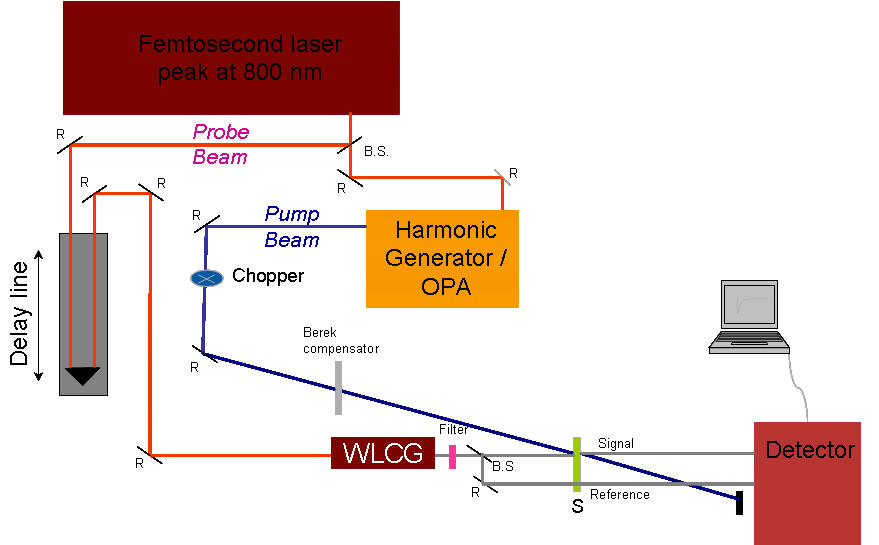Del Mar Photonics - Hatteras Advantages -
Eric Wei-Guang Diau publication
Hatteras brochure -
Request a quote -
Custom Femtosecond Transient Absorption Data Acquisition Systems
 |
Femtosecond Transient Absorption Measurements system
Hatteras.
Future nanostructures and biological nanosystems will take
advantage not only of the small dimensions of the objects but of the
specific way of interaction between nano-objects. The interactions
of building blocks within these nanosystems will be studied and optimized on
the
femtosecond time scale - says Sergey Egorov, President and CEO of Del Mar
Photonics, Inc. Thus we put a lot of our efforts and resources into the
development of new Ultrafast
Dynamics Tools such as our Femtosecond Transient Absorption Measurements
system Hatteras. Whether you want to
create a new photovoltaic system that will efficiently convert photon energy
in charge separation, or build a molecular complex that will dump photon energy
into local heat to kill cancer cells, or create a new fluorescent probe for
FRET microscopy, understanding of internal dynamics on femtosecond time scale
is utterly important and requires advanced measurement techniques. |
Del Mar Photonics featured customer Christien A Strydom
Making sense of measurements in femtochemistry
Speaker / Author: Christien A Strydom1
Co-author(s): L.R. Botha2, A. du Plessis2, S.
Obinda-Lemboumba2
1School of Chemistry, North-West University, Private Bag X6001,
Potchefstroom, 2520,
South Africa
2CSIR National Laser Centre, Meiring Naude Road, Pretoria, 0001,
South Africa
Abstract
Chemical bonds break, form and change position in the three
dimensions with ultra fast
speed. These transformations are dynamic processes involving the mechanical
motion of
electrons and atomic nuclei. In order to measure the processes over a distance
of an angström,
the average time required is ~100 femtoseconds (fs). Femtochemistry is the field
of study
where atomic motions as reactions occur are investigated [1]. Femtosecond
resolution (10-15
seconds) and intervention is needed to study and control the dynamics of
chemical bond
formation and breakage on an atomic level.
Making sense of the measurements in this time domain is complex and needs to be
done in an
indirect manner. As 21st century electronics is not able to measure within
femtoseconds,
variations in the optical path length of the laser beams are used to obtain time
resolution.
Timing is accomplished by generating pump and probe laser pulses from a common
source
and sending either the pump or probe pulse along an adjusted optical path. The
path length
difference relates to the time difference as both pulses move at the constant
speed of light
(2.999792 x 108 m/s).
Several pump-probe femtosecond laser activation studies have been done on
malachite green
and it was decided to verify the experimental set-up using this activation
process. Measured
pump-probe signals have shown that malachite green has an ultra short electronic
excited
state lifetime [2]. Transient absorption signals of malachite green in an
ethanol solution
pumped at 580 nm and probed at 620nm have shown a fast kinetic process with a
time
constant of approximately 2.1 ps [3]. In this paper we report on results
obtained with
malachite green using a newly commissioned pump-probe
femtosecond laser system.
Full article

Monitoring the intermediate (transient)
concentration using a time delayed probe pulse
pump-probe femtosecond laser system.
Full article

The overlap of pump and probe beams. The probe beam is split
into a signal and the reference part.

pump-probe femtosecond laser system.
Full article
A Ti: sapphire oscillator (Coherent Mira-optima 900-F oscillator) and amplifier
(Coherent
Legend-F with repetition rate 1 KHz) at 795 nm produces ultra short laser pulses
with pulse
duration of 117 fs. This beam is split by a beam splitter into pump and probe
parts (90 %
transmitted and 10 % reflected). The probe beam is sent to a variable optical
delay line,
which is set on a precision translation stage controlled by a computer. The
optical delay is
necessary in order to get a real-time rapid-scan acquisition by temporally
changing the pump
and probe beam overlap in the sample [12,13]. The probe beam is then focused on
a sapphire
plate (1-2mm thick [12,13]) to generate a white light super continuum. A short
pass filter is
placed on the probe path in order to suppress the strong residual peak at 800 nm
from the Ti:
sapphire laser.
The probe beam then is split into two beams, giving reference and signal beams.
The signal is
focused on the sample in such a way it that overlaps spatially with the pump
beam in the
liquid sample while the reference beam is sent through the sample as indicated
in Figure 5.
The pump pulse is sent through an optical parametric amplifier (TOPAS C - OPA)
in order to
obtain a wide tuning range of the pump beam (530-20000 nm). After the OPA a
chopper is
inserted in the pump beam path to record spectra that are classified as pumped
and not
pumped, thereby reducing background effects. For detecting the transient
absorption, a
spectrometer combined with a photodiode array (PDA) is used.

Pump-probe femtosecond laser experimental setup
pump-probe femtosecond laser system.
Full article
References
1. A.H. Zewail, J. Phys. Chem. A , 104, 24, 2000, pp. 5660 – 5694.
2. Y. Nagasawa, Y. Ando, A. Watanabe and T. Okada, Applied Physics B, 70, 2000,
pp. S33-S34.
3. G. Schweitzer, L. Xu, B. Craig and F.C. DeSchryver, Optics Communication,
142, 1997, pp. 283-288.
4. http://nobelprize.org/nobel_prizes/chemistry/laureates/1999
5. http://www.chemguide.co.uk/analysis/ir/background.html
6. V. Letokov, Laser Control of Atoms and Molecules, 2007, Oxford University
Press, ISBN: 978-0-19-852816-6, p. 225.
7. J.S. Baskin and A.H. Zewail, J. Chem.Ed., 78, 6, 2001, pp. 737 – 751.
8. H.Y. Chen, I.R. Lee and P.Y. Cheng, Review of scientific instrument, 77,
2006, p. 076105.
9. M. Dantus and P. Gross, “Ultrafast spectroscopy”, Encyclopedia of Applied
Physics, 22, 1998.
10. N.E. Henriksen, Chem Soc. Rev., DOI: 10.10139/b100111f
11. G.D. Reid and K. Wynne, “Ultrafast Laser Technology and Spectroscopy”.
Encyclopedia of Analytical chemistry, R.A. Meyers (Ed), 2000, pp 13644-13670.
12. G. Cerullo, C. Manzoni, L. Luer and D. Polli, Photochemical &
photobiological sciences, 6, 2007, pp 135-144.
13. C.C. Gradinaru, I.H.M. van Stokkum, A.A. Pascal, R. van Grondelle and H. van
Ameronen, J. Phys. Chem., 104, 2002 , pp 9330-9342.
14. M. Fukuda, O. Kajimoto, M. Terazima and Y. Kimura. J. Mol. Liquids, 134,
2007, pp. 49-54.
Del Mar Photonics
Related Del Mar Photonics products
Femtosecond Lasers
Trestles
femtosecond Ti:Sapphire laser
Trestles Finesse
femtosecond Ti:Sapphire laser with integrated
DPSS pump laser
Teahupoo Rider
femtosecond amplified Ti:Sapphire laser
Mavericks
femtosecond Cr:Forsterite laser
Tamarack
femtosecond fiber laser (Er-doped fiber)
Buccaneer
femtosecond OA fiber laser (Er-doped fiber) and SHG
Cannon Ultra-broadband
light source
Tourmaline femtosecond Yt-doped
fiber laser
Femtosecond pulse measurement instrumentation
Reef
scanning and single shot femtosecond autocorrelators
Avoca SPIDER
Spectral phase interferometry for direct electric-field reconstruction (SPIDER)
Rincon
third order femtosecond cross-correlator (third order autocorrelator TOAC) also
referred to as contrastmeter
Ultrafast Dynamics Research Tools
Beacon
femtosecond fluorescence up-conversion (optical gating) spectrometer
Hatteras Ultrafast Transient Absorption Spectrometer
Femtosecond Systems and Accessories
Femtosecond
Micromachining
Femtosecond
nanophotonics
Femtosecond NSOM
Pacifica femtosecond
fiber laser based terahertz spectrometer
Pismo pulse
picker (ultrafast electro-optical shutter)
Wavelength conversion: second and third harmonics generators for femtosecond
lasers
Jibe white light
continuum generator
Kirra
Optical Faraday Rotators and Isolators
Laser accessories
Diffractive Variable Attenuator
for high power lasers
Deformable mirrors - active elements for adaptive optics systems
ShaH -
the family of fast, accurate and reliable wavefront sensors
Complete adaptive
optics systems
Faraday rotators and
isolators for high-power (up to 1kW) laser beams
SAM - Saturable Absorber
Mirrors
High repetition rate DPSS
lasers



